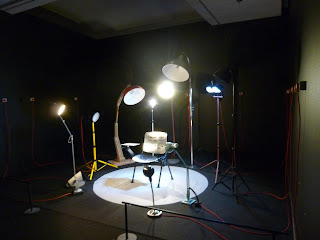 |
| Ng Eng Teng's Tropical Rhapsody. |
Several months ago, I visited the NUS Museum to be better acquainted with the art of late Singapore sculptor, Ng Eng Teng (1934 - 2001). During that visit, there was a section titled Biography of a Public Sculpture - Salvaging and Conserving that has caught my attention. This section discussed the process of salvaging and conservation of two murals created by Ng Eng Teng for the Garden Hotel in 1971. These two murals were Asian Symphony and Tropical Rhapsody.
Asian Symphony is Ng Eng Teng's largest known public mural measuring 1.83 x 9.14 x 0.19 metres. Comprising ten panels, it was commissioned for the Garden Hotel "as a reflections into nature, its beauty and the human ideals".
Before the Garden Hotel (located at 140 Balmoral Road) was demolished in 2010, the two murals were salvaged and donated to NUS. The process of surveying, dismantling and reinstalling the murals appeared to be a time-consuming task requiring a lot of planning. I learnt that before dismantling Asian Symphony, a multidisciplinary team had to carry out detailed investigation to determine how the mural could be safely dismantled. This was necessary as there was no available documentation of how the mural was installed.
Biography of a Public Sculpture - Salvaging and Conserving will give visitors a glimpse of the processes involved in salvaging the two murals through the display of related images and artefacts.
At the NUS Museum, I learnt that digital scans of Asian Symphony were being made as a precautionary measure. The digital scans were intended to capture three-dimensional data of the data so that a model of the work could be reproduced should the original be destroyed by accident during the dismantling process. Subsequently, synthetic polymer scale model of Asian Symphony was produced.
 |
| A 1/20th synthetic polymer scale model of Asian Symphony produced from digital scan. |
At the NUS Museum, I read that the Asian Symphony was made by Ng Eng Teng in 1971 for the Garden Hotel's lobby while Tropical Rhapsody was commissioned for the hotel's lounge. This puzzled me. I had visited Garden Hotel sometime around year 2000 but did not recall seeing any of the two works.
I consulted my father who had used to work at the Garden Hotel and learnt that sometime in 1981, after a series of renovation works, the previous Garden Hotel's lobby area (where the Asian Symphony used to be displayed) was converted into a function room. Unless I had visited the function room after 1981, I would have missed this mural. I also learnt that after that renovation in 1981, the previous lounge area was converted into a cafeteria and a partitioning wall was built just in front of Tropical Rhapsody which restricted the public's access to this other mural.
After the visit to NUS Museum, I felt thankful that Kechapi Pte Ltd which owned the murals had an appreciation of the artistic value of the murals and donated them to NUS.
I consulted my father who had used to work at the Garden Hotel and learnt that sometime in 1981, after a series of renovation works, the previous Garden Hotel's lobby area (where the Asian Symphony used to be displayed) was converted into a function room. Unless I had visited the function room after 1981, I would have missed this mural. I also learnt that after that renovation in 1981, the previous lounge area was converted into a cafeteria and a partitioning wall was built just in front of Tropical Rhapsody which restricted the public's access to this other mural.
 |
| Ng Eng Teng's Asian Symphony. |
After the visit to NUS Museum, I felt thankful that Kechapi Pte Ltd which owned the murals had an appreciation of the artistic value of the murals and donated them to NUS.
Currently, Asian Symphony is installed at the ground floor of National Health System Building while Tropical Rhapsody is displayed at the NUS Museum. If you happen to be nearby these two locations, please do check these two murals out.
NUS Museum
University Cultural Centre
50 Kent Ridge Crescent
National University of Singapore
Singapore 119279
Tel: (+65) 6516 8817
Nearest MRT station: Clementi
Closed on Mondays.
NUS Museum's website: http://www.nus.edu.sg/cfa/museum/index.php |
| Ng Eng Teng's Asian Symphony. Located in an enclosed garden which is nearby the main lobby of NUHS. |
NUS Museum
University Cultural Centre
50 Kent Ridge Crescent
National University of Singapore
Singapore 119279
Tel: (+65) 6516 8817
Nearest MRT station: Clementi
Closed on Mondays.
National University Health System Building
1E Kent Ridge Road
Singapore 119228
Nearest MRT station: Kent Ridge (Exit B)
Please click this link for map and directions.
***
Please also read:
http://www.ne.edu.sg/ljs/lj_nusmuseum.htm
http://infopedia.nl.sg/articles/SIP_1362_2008-11-29.html
What is Art Conservation? (NUS Museum) (worksheet)
Working the Tropical Garden
Working the Tropical Garden by Su Ling Foo, Devika Murugaya, Conservation Studio
Publication: Working the Tropical Garden
Working the Tropical Garden (Brochure of past exhibition, by NUS Museum)
Post by Ahmad Mashadi. Some thoughts on "Sculpting a National Identity" by Ong Soh Chin
1E Kent Ridge Road
Singapore 119228
Nearest MRT station: Kent Ridge (Exit B)
Please click this link for map and directions.
***
Please also read:
http://www.ne.edu.sg/ljs/lj_nusmuseum.htm
http://infopedia.nl.sg/articles/SIP_1362_2008-11-29.html
What is Art Conservation? (NUS Museum) (worksheet)
Working the Tropical Garden
Working the Tropical Garden by Su Ling Foo, Devika Murugaya, Conservation Studio
Publication: Working the Tropical Garden
Working the Tropical Garden (Brochure of past exhibition, by NUS Museum)
Post by Ahmad Mashadi. Some thoughts on "Sculpting a National Identity" by Ong Soh Chin


































.jpg)






.jpg)

